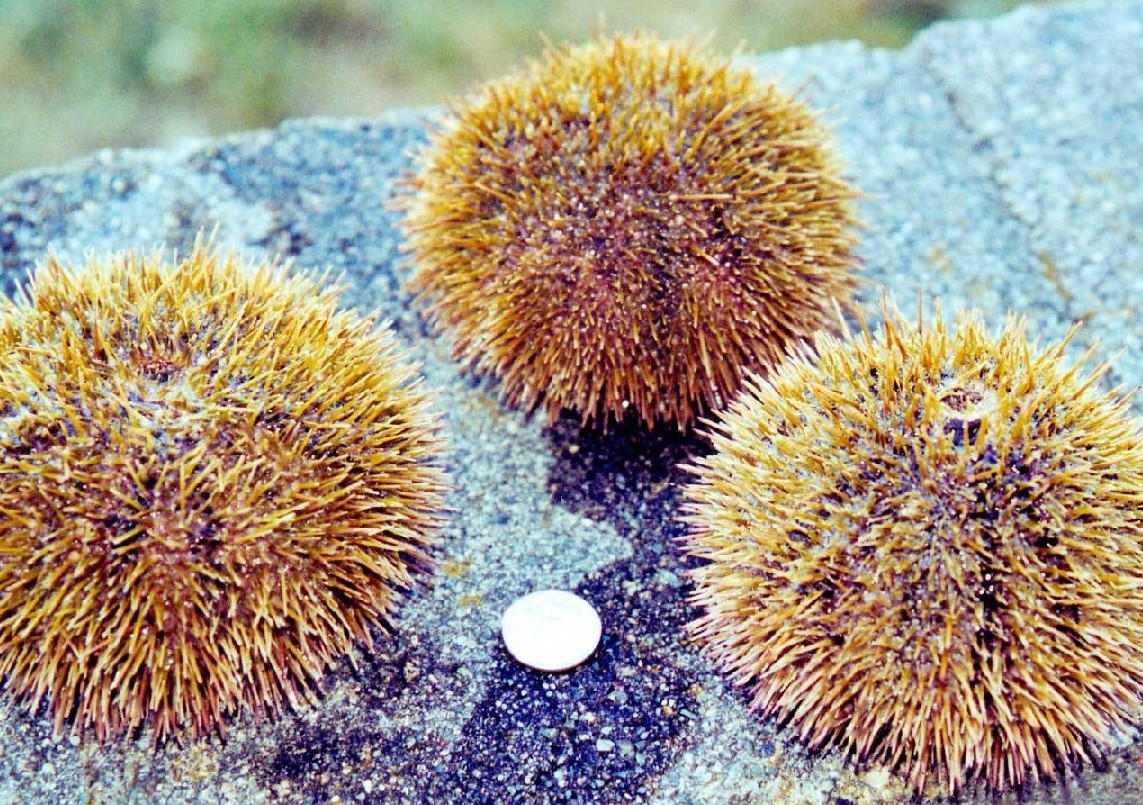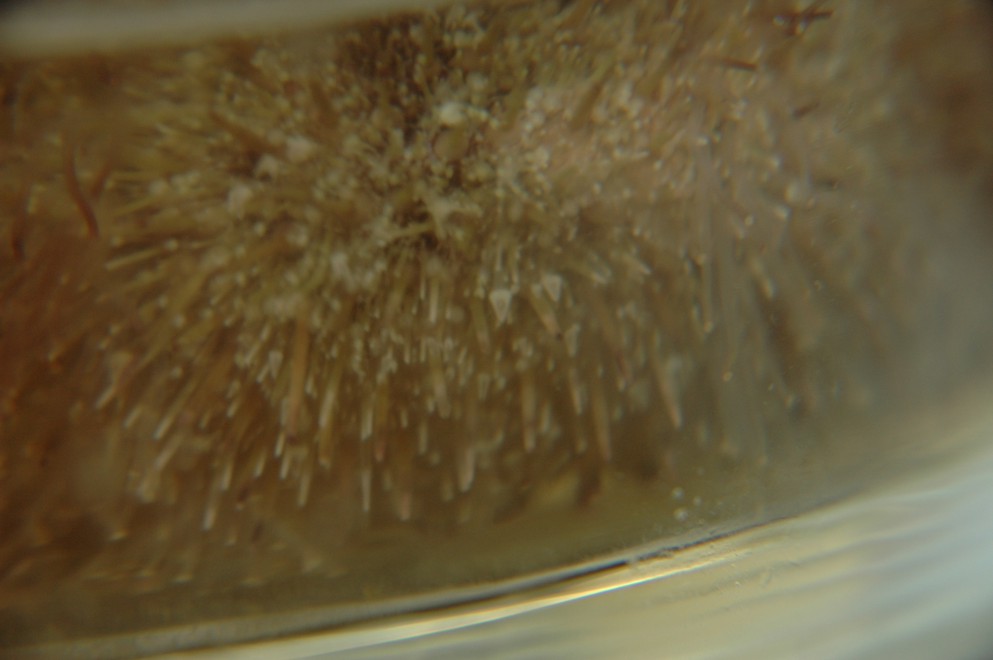Strongylocentrotus droebachiensisGreen Sea Urchin |
|
 |
|
| Phylum Echinodermata
Class Echinoidea Order Echinoida Family Strongylocentrotidae |
|
| These three S. droebachiensis were found on a dredge in Friday Harbor | |
| Photo taken by Heidee Leno. July 2002 | |
How to Distinguish from Similar Species: Since juvenile S. purpuratus urchins may have pale green spines, S. droebachiensis may be mistaken for them. S. pallidus, a deep subtidal species, is a lighter green and its tube feet are as light or lighter than its spines.
Habitat and Range: In both sheltered and exposed kelp beds and rocky areas, located in the low intertidal zone and subtidal zone to 1,200 meters in the Atlantic Ocean. These urchins range from Alaska to the Puget Sound. They may also be found on the Atlantic coast and in Europe. This and S. pallidus are the only species of urchin in the Puget Sound area that are also found in the NW Pacific off Russia (Bazhin, 1998). Bazhin also says that the species is sometimes found but is not common in many areas of the Arctic Ocean so it should not necessarily be considered a circumpolar species.
Biology/Natural History: S. droebachiensis feed on large algae such as bull kelp, green algae, and laminarians. They also scrape diatoms and coralline algae off rocks. They are harvested commercially for their roe, which is a delicacy in Japan. In the Gulf of Maine, males at widely separated populations seem to be release sperm at similar times, suggesting that they are responding to a widespread environmental signal. Spawning was most intense during full and new moon (spring tides). However, extensive sperm release seems to occur mainly in large urchin swarms, suggesting that the presence of spawning of nearby urchins triggers spawning by others (Gaudette et al., 2006). In the Barents Sea, Russia, spawning peaks late February to April, in temperatures ranging from 0.4 to 1.8 C (Oganesyan, 1998).
Microsatellite analysis (Addison and Hart, 2004) shows strong population differentiation between Pacific and Atlantic populations. This shows there is little gene flow between the Atlantic and Pacific populations.
Johnson et al., (2012) demonstrated that several different fluorchromes persisted for months to years in the ossicles of S. droebachiensis (in Maine, Atlantic ocean) and could be used to measure growth without harm to the animals.
A MRI scan of the internal anatomy of this species, performed by Ziegler et al., (2014), is publically available.
According to Strathman (1980), S. pallidus and S. droebachiensis overlap in the Salish Sea in both depth and habitat. In the lab S. droebachiensis eggs can be readily fertilized by S. pallidus sperm but fertilization of S. pallidus eggs by S. droebachiensis sperm is almost totally unsuccessful. Hybrid S. droebachiensis-S. pallidus females resemble S. droebachiensis. They are fertile, and more readily fertilized by S. pallidus than by S. droebachiensis
sperm. Male hybrids were not successfully raised to maturity. The two
species often compete for kelp in the laboratory. If there is a clear
winner in this competition, it is usually S. droebachiensis.
| Return to: | |||
| Main Page | Alphabetic Index | Systematic Index | Glossary |
References:
Dichotomous Keys:
Flora
and Fairbanks, 1966
Kozloff
1987, 1996
Smith
and Carlton, 1975
General References::
Lambert
and Austin, 2007
Sept,
1999
Scientific Articles:
Addison, J.A. and M.W. Hart, 2004. Analysis of population genetic structure of the green sea urchin (Strongylocentrotus droebachiensis) using microsatellites. Marine Biology 144:2 pp. 243-251. DOI:10.1007/s00227-003-1193-6
Bazhin, A.G., 1998. The sea urchin genus Strongylocentrotus in the seas of Russia: Taxonomy and ranges. pp 563-566 in Rich Mooi and Malcolm Telford (eds), Echinoderms: San Francisco. Proceedings of the Ninth International Echinoderm Conference, San Francisco, California USA 5-9 August 1996.
Bookbinder, L.H. and J.M. Shick, 1986. Anaerobic and aerobic energy metabolism in ovaries of the sea urchin Strongylocentrotus droebachiensis. Marine Biology 93: pp 103-110
Gaudette, Julien, Richard A. Wahle, and John H. Himmelman, 2006. Spawning events in small and large populations of the green sea urchin Strongylocentrotus droebachiensis as recorded using fertilization assays. Limnology and Oceanography 51:3 pp. 1485-1496.
Johnson, Amy S., Jordan M. Salyers, Nicholas J. Alcorn, Olaf Ellers, and Jonathan D. Allen, 2012. Externally visible fluorochrome marks and allometries of growing sea urchins. Invertebrate Biology 132:3 pp 251-269
Leddy, H.A., 1998. Walking versus breathing: Functional morphology of oral and aboral podia from the green sea urchin, Strongylocentrotus droebachiensis. p 730 in Rich Mooi and Malcolm Telford (eds), Echinoderms: San Francisco. Proceedings of the Ninth International Echinoderm Conference, San Francisco, California USA 5-9 August 1996.
Lyons, Devin A. and Robert E. Scheibling, 2007. Differences in somatic and gonadic growth of sea urchins (Stronglyocentrotus droebachiensis) fed kelp (Laminaria longicruris) or the invasive alga Codium fragile ssp. tomentosoides are related to energy acquisition. Marine Biology 152:2 pp. 285-295. DOI:10.1007/s00227-007-0682-4
McEdward, Larry R. and Benjamin G. Miner, 2006. Estimation and interpretation of egg provisioning in marine invertebrates. Integrative and Comparative Biology 46:3 pp 224-232
Oganesyan, S.A., 1998. Reproductive cycle of the echinoid Strongylocentrotus droebachiensis in the Barents Sea. pp. 765-768 in Rich Mooi and Malcolm Telford (eds), Echinoderms: San Francisco. Proceedings of the Ninth International Echinoderm Conference, San Francisco, California USA 5-9 August 1996.
Selden, Rebecca, Amy S. Johnson, and Olaf Ellers, 2009. Waterborne cues from crabs induce thicker skeletons, smaller gonads and size-specific changes in growth rate in sea urchins. Marine Biology 156:5: pp. 1057-1071. DOI:10.1007/s00227-009-1150-0
Strathman, Richard R., 1980. On hybridization and competition between Strongylocentrotus droebachiensis and Strongylocentrotus pallidus. Page 413 in Michel Jangoux, editor. Echinoderms: Present and Past. Proceedings of the European Colloquium on Echinoderms, Brussels, 3-8 September 1979. 428 pp.
Wheatley, K., R.G. Brown, and R.E. Scheibling, 1998. Coelomocyte oxidative activity of the green sea urchin (Strongylocentrotus droebachiensis) following challenge by bacterial and amoebic pathogens. pp. 881-886 in Rich Mooi and Malcolm Telford (eds), Echinoderms: San Francisco. Proceedings of the Ninth International Echinoderm Conference, San Francisco, California USA 5-9 August 1996.
Ziegler,
Alexander, Cornelius Faber, Susanne Mueller, Nina Nagelmann, and Leif
Schroder, 2014.
A dataset comprising 141 magnetic resonance imaging scans of
98
extant sea urchin species. GigaScience 2014, 3:21 doi:
10.1186/2047-217X-3-21 (Open access)
Web Sources:
Kodiak Laboratory, Alaska Fisheries Science Center,
www.afsc.noaa.gov/kodiak/photo/grurch.htm
Marine Life Information Network for Britain and Ireland-
MarLIN,
Species Information for Strongylocentrotus droebachiensis,
www.marlin.ac.uk/demo/Strdro.htm
General Notes and Observations: Locations, abundances, unusual behaviors, etc.:
This species is abundant subtidally in rocky areas of Northwest Island and Sares Head.

In this view, several stalked pedicellariae can be seen waving around
among the spines in the center of the picture.
Authors and Editors of Page:
Created original page: Heidee Leno (2002)
Edited by Hans Helmstetler 12-2002
Edited by: Dave Cowles 2002-